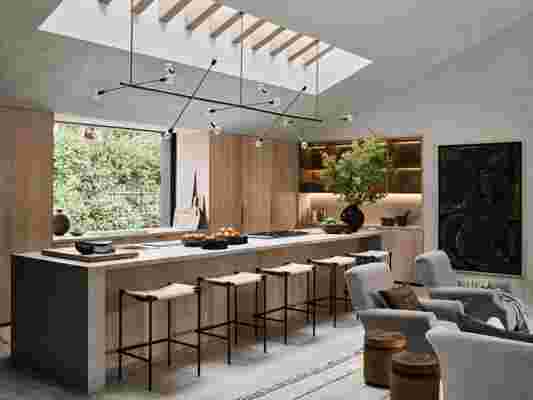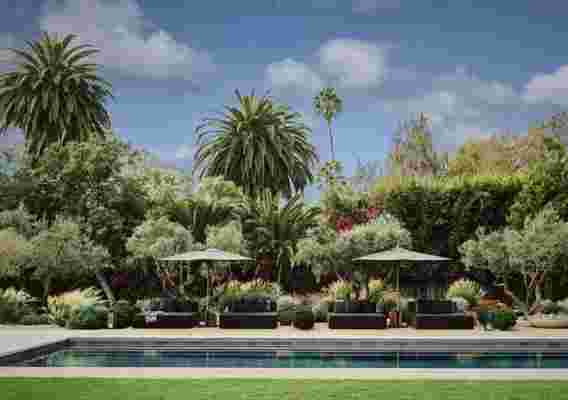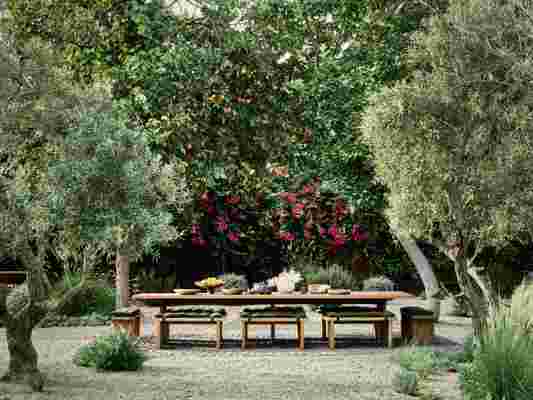By virtue of its solitary whereabouts under the shade of mature oaks and maples in Bonsall Canyon, the family home that designer Vanessa Alexander shares with her husband Steve and three teenage sons quietly shifts the idea of what exactly makes for a quintessential Malibu pad. For one thing, this down-to-the-studs remodel is connected to the land, not the ocean. It’s also less conspicuous and more cocooning, by design and circumstance: As fate would have it, the unwitting quarantine compound was completed just weeks before the pandemic struck last March.
“This is definitely not a sun-worshipping beach house,” says Alexander of the third Malibu home that she and Steve, a Hollywood agent, have built together. That figure includes residences in the celebrity shoreline enclave of Point Dume and the gated waterfront community of Serra Retreat. “We don’t see the ocean from here. Instead, we see mountains and big trees, but the most remarkable part about this landscape is the painterly quality of the light.”

Given its promise of food with a view, family hangouts mostly happen in the home’s kitchen. A long sight line stretches from the room through the adjacent family area and out to the pool. “This is where we gather after coming home from our disparate lives,” designer Vanessa Alexander says. The unique slotted skylight echoes the floating stairs in the entry hall.
Dappled through leaf canopies, this supple illumination gives the home’s ebony exterior a more ethereal presence—a suggestion of a dwelling, or even the shadow of one. The couple and their frequent collaborator, Los Angeles–based Kovac Design Studio, took cues for the architecture from old Belgian stone farmhouses, further clarifying an already simple agrarian form down to its essence: a basic silhouette defined by the classic single-gable pitch; wide portals that offer an easy connection to the outdoors; and humble wood cladding emblematic of the home’s rustic inspiration. Cedar panels were given a centuries-old Japanese treatment called shou sugi ban , a method of preserving wood by charring it. “The darkness feels dramatic and low-key at the same time,” Alexander says. “And it makes the house sit on the land in a really interesting way.”
Save for a few moody, oversized canvases inside the house—a ghostly female nude in the primary bedroom, for instance, or a dim landscape hanging in the dining room—the exterior’s total eclipse doesn’t really seep into the decor. Instead, the obscurity gives way to a tonal tableau that recalls the sublime light of Bonsall Canyon. Throughout the house, sumptuous textures, from cashmere drapery to walls of hand-applied plaster—craftsmanship that, Alexander says, “turns a surface without art into art”—offers warmth. Lingering is encouraged by seating made for sinking into, like a pair of Marco Zanuso Regent chairs in the living room. Covered in suede, these cuddly pieces practically purr.


Buy now for unlimited access and all of the benefits that only members get to experience.
More storied objects give the new home a sense of heritage. In the family room, a Peter Samuelson painting—scratch art of the blue-chip kind—was a gift from Alexander’s mother, an antiques expert who traveled the world on buying trips with her young daughter in tow. The stairwell’s sculptural bench, fashioned from a salvaged log with a natural crook angled just so, is a primitive counterpoint to the graceful risers floating above. Occasional flashes of aged brass, whether from threshold trims or the Pick Up Stick chandelier by Cam Crockford in the primary bedroom, add opulence in microdoses.
“It’s a boys world over here, so while the design is elegant and has moments of luxury, it’s still meant to be lived in,” Alexander says. The family has averaged four years in each house (a designer’s burden), but Steve seems to think they’ve settled into their forever home. “You could say that our third time at bat we hit it out of the park,” he says.
